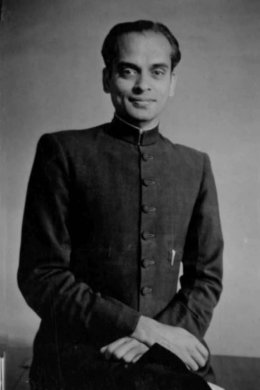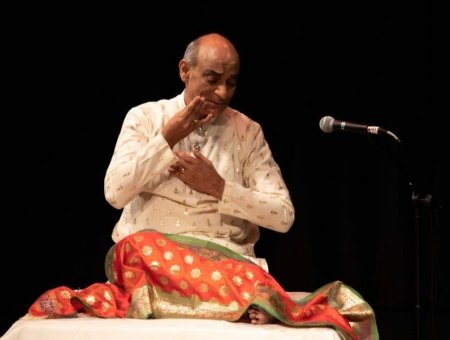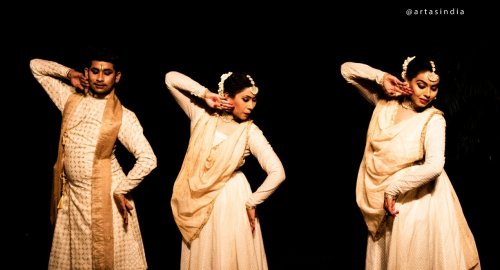
|   |

|   |
 e-mail: leelakaverivenkat@gmail.com Fond memories of generous contribution of Guru Kallianpurkar - Kathak's non gharana legator Photos: Subhash Chandra archives & Arijit Mukherjee April 7, 2022 Conceived by Kathak teacher Subhash Chandra as a tribute to his beloved late Guru Mohanrao Kallianpurkar, and sponsored by the Guru's family in celebration of their father/grandfather, with patronage provided by the design and fashion house Elara Productions run by 'yuvakalakars' Devika Agarwal and Shreejeeta Ghosh (students of Guru Subhash Chandra), the evening of Ek Antarang presented at Vivekananda Auditorium in association with the Kathak Kendra, despite the technical glitches testing the online viewer's attention, had its moments, while remembering a great Guru. Describing the Guru as the lighthouse in a dark world, director of Kathak Kendra, Suman Kumar, the guest of honour, specially referred to the contribution of a Guru who had left his creative legacy for the entire Kathak world - irrespective of the family line or Kathak school one represented. In a gharana bound community, this kind of open ended approach was rare. It can be explained by the fact that as a highly educated scholar (whose designing of the entire teaching method for Kathak is still the prescription in the Bhatkhande School), Mohanrao Kallianpurkar's lifetime (12 August 1913-1985 ), with most of his years spent in Kathak, was spurred entirely by love for the dance - hailing, as he himself did, from Hubli in Karnataka from a totally non Kathak family background.  Mohanrao Kallianpurkar Mohanrao Kallianpurkar, having studied under renowned Gurus like Sunderprasad, Achhan Maharaj and Shambhu Maharaj, had imbibed from teachers of both gharanas of Jaipur and Lucknow. As a teacher, he taught items from both the schools, giving credit to the creative source, and never distorting the stylistic parentage in his presentation. While preserving in its original form whatever he had acquired, he did not believe in vocal declarations of allegiance to any one particular gharana. While on the subject of gharana, it must not be forgotten that Guru Sunderprasadji's school in Bombay was named after Bindadin Maharaj, the Lucknow stalwart - even as Jaipur gharana dancers vociferously insist on Sunderprasadji's Rajasthani vintage, with the argument that the institutional name just honoured a founder of the Kathak tradition. Guru Subhash Chandra however declared that Sunderprasadji was a 'gandabandh' student of Maharaj Bindadin (1830-1918) - a point on which, this critic has run into many Kathak voices in total denial of this claim, with some in agreement. According to Subhash Chandra, on his own request, Abha, the student of Rohini Bhate (a very respected shishya of Mohanrao Kallianpurkar), had approached scholar Puru Dhadheech and had this statement confirmed about Sunderprasadji (who passed away in 1970) that as a youth in Lucknow, he had received training from Guru Bindadin Maharaj himself. Subhash Chandra followed this up with a printed article sent to me, the visible part of it having Mohanrao's declaration, that his learning under Guru Achhan Maharaj was without any 'Gandaband' formalities being insisted on - because Mohanrao was a student of Sunderprasadji, who was regarded as a Guru bhai by the family. When Sunderprasadji came away to Delhi in 1958 to be with BKK's Kathak Kendra, his Bindadin School (started in 1936/some records say 1937) had his prime disciple Mohanrao Kallianpurkar in charge. But when S.N. Ratanjankar, scholar and musicologist supreme of Bhatkhande 's Music Institute at Lucknow, (later Vice Chancellor, Indira Kala University at Kairagarh) approached Sunderprasadji a couple of years later, asking for Mohanrao Kallianpurkar as a member of the faculty at Bhatkhande Music College, the Guru could not refuse and Kallianpurkar joined Bhatkhande, where he served till his retirement in 1967.  Mohanrao Kallianpurkar Subhash Chandra who was learning Kathak under Mohan Krishnaji in Benares as a gandabandh shagird (much before the guru's son Vishal Krishna was anywhere on the horizon), had also studied music under Balwant Rai Bhatt. That was a time when Kumudini Lakhia came to Benares with Atul Desai as her singer. In Benares, Subhash Chandra had his first glimpses of Kallianpurkar, who often came as an examiner, along with gurus like Lachhu Maharaj. Later he had some interaction with him when the Guru was at Chakradharpur. During his workshop in Ahmedabad's Kadamb, when Kumudini Lakhia had to be away in Lahore performing, Subhash Chandra watching what he describes as the 'adbhut' demonstrations of Guru Kallianpurkar was fired by the urge to learn from him. But when he approached the Guru and expressed his desire to be accepted as his student, the Guru's rejoinder that he was already learning from him did not satisfy him. Subhash's attempt to dazzle the Guru with the virtuosity and chakkars of the style he had been learning (One cannot however recollect ever having seen Subhash presenting anything vigorous) prompted the assessment, "There is nothing in your dance. You are whirling constantly and unable to remain in one place for any movement to register and say anything." Braving the carping criticism, that Subhash Chandra still managed to achieve his ambition by coming under this Guru's baton from 1979-1984, speaks of his doggedness, when set on something.  Subhash Chandra and Rashmi Vajpeyi In an interaction with Rashmi Vajpeyi on his career with Guru Kallianpurkar, after 1985, Subhash came away to Kathak Kendra and trained under gurus like Reba Vidyarthi and Guru Munna Shukla. But by his own admission, the ang instilled in him under Guru Kallianpurkar never got erased. He spoke of how in order to learn from Guruji, he had often to leave his place in Mumbai's Borivili hours before the class began at Churchgate, constantly battling against the travails of the city's commuting hazards during monsoons. Overcome by a remark of his teacher, with slightly drenched eyes, Subhash recollected how the Guru, on looking at the bedraggled, drenched shishya ringing the door bell, had observed that there was no need to try and make it in such inclement weather. Subhash's answer that he did not want to miss a class had prompted the remark, "That you have a great desire to learn, is evident." It was mentioned in the interaction that those were the days when even Gurus like Achhan Maharaj and Shambhu Maharaj were referred to as doing Natwari Nritta. The term 'Kathak' was a later development. Touching on Kallianpurkar's style of dance, it was mentioned that one could find Achhan Maharaj's ang in Mohanrao's Kathak. The film screened on the occasion of Ek Antarang (in the first showing carried too many technical hazards and had no sound) visualised the Guru, turned out in the broad flapping pyjamas of the times, presenting gath - his tall relaxed presence, clean ang (the hands with slender long fingers standing out) revealing in the dance, a serenity of inner quietude. With the sound problems sorted out, the film on a second showing, was informative with senior students like Padma Sharma speaking on the prowess of this guru - adept in tabla, in playing sitar, in singing, and in dancing with an easy way of teaching, and who combined a sense of humour along with a total absence of any impatience or anger. She particularly mentioned his bhav while presenting the thumri Mano Manona Bihari. She also spoke of his extreme generosity in making available to students opportunities for exchanging one-to-one interactions with the greatest of gurus who came and stayed with him, off and on, as his guests. "Come early, and I will introduce you and you can learn something from him in a one-to-one exchange, he would say, and I learnt a lot from these incidental exchanges." Poornima Pandey spoke of how invaluable the contribution of this guru was, in those days - with his all round grasp over sangeet in its totality - with Gayan, Vadya and Nritya. A linguist of no mean dimension, he spoke in Hindi, Kannada, was well versed in Sanskrit, knew Bengali, fluent English and many other languages. What he gave to the students in his laya bant, his andaz which was special and play with laya in general, was unbelievable. What he left behind as a Kathak teaching syllabus for his successors is an everlasting contribution. He also choreographed works like Sakuntala, Vikramorvasiyam, Malati Madhav, Meghdoot. Poornima mentioned finding Guruji's Thaat and Gat styles reflected in Subhash Chandra's Kathak, though he had come under Kallianpurkar towards the end of Guruji's teaching years. Roshan Date spoke of working with Guruji in a Bangalore workshop. From Bangalore, Guru B. Nagaraj was all praise for how Kallianpurkar who belonged to Mysore State, became such a reputed Guru in Kathak. In the exchange with Rashmi Vajpeyi, Subhash, talking about Kallianpurkar's ang, remarked that the totality of all that this Guru derived from his three famous Gurus, had the inimitable alchemy of Mohanrao's own inner stylistic inclinations - of which there is no description, for he was never one to speak about himself. "I asked Rohiniji, his very close shishya and she also said that Kallianpurkar never claimed anything as his own contribution, so deep was his Guru bhakti. He himself was never the subject of any conversation. His repertoire had three Ganesh Parans, well recited by Subhash Chandra - of which the "Jhe jhe jhe kritakuna tarikiyo..." which he got from Sunderprasadji, was said to be his favourite. He acquired another Ganesh Paran from Sakaramji, as 'daan' - and the third Paran which Guruji had in his repertoire, was from Guru Achhan Maharaj. They were all recited beautifully, though performing all three would have demonstrated the physicality the words are draped in - for dance is after all about movement. When asked about what Mohanrao valued most, Subhash answered that it was vilambit laya and that he had always maintained that perfection in this laya automatically meant immaculate rendition in the drut laya.  Subhash Chandra Subhash presented Lamchar Thaat, which Guru Achhan Maharaj first presented in the Chakradhar Durbar and which Kallianpurkar learnt and which Subhash said was taught in different ways to different students (with even Kartik Ram of Raigarh and many others presenting it - but in slightly varied ways). Thaat incorporated 'chal' in it, as in Jaipur gharana, and was not restricted to stances. Kallianpurkar's Amad which he had learnt from Shambhu Maharaj, the Sangeet ka Tukdas, Talwar ki Gat were all discussed and recited. But unfortunately, Subhash Chandra's inability to perform each piece due to some problem in the leg (as was mentioned), reduced the danced part only to softer items. Subhash's dogged perseverance of his Guru's ang, amidst the plethora of other influences in the contemporary scenario (which by creeping in dilute styles purely wedded to the original source), is no mean achievement. But by not also dipping into the strong laya play of Kallianpurkar, which the guru received from the great layakari Sunderprasadji himself, in today's performance climate, where the purely placid has few takers, puts spokes in the way of Subhash's type of dance. It was even suggested that Kathak Kendra as an example of Guru Kallianpurkar's ang for the records, could video what Subhash can present. Subhash Chandra emphasised right through how close Rohini Bhate was to Kallianpurkar. It was mentioned that Guruji and Rohini were two sides of the same coin- so closely did she reflect the Guru's repertoire. "I am empty from inside. I am filled by what the Guru gives me," she claimed. Very often when Subhash Chandra mentioned his desire to learn a particular item from Guru Kallianpurkar, he was told to go to Rohini Bhate for he had taught her the item. The belief in Rohini was so complete - that she would teach it to another in exactly the same form in which she had received it from the Guru. But in all this, one must remember that Rohini Bhate herself, as a scholar and performer, had her own evolved originality and while Guru Kallianpurkar's items are meticulously and faithfully preserved, the stylistic part obviously would reflect a lot of Bhate in it. Guru Kallianpurkar was also said to have learnt gats from Guru Vikramji , for whom he had a great deal of respect. Also discussed were Dha ta ka thunga with bhav which Guruji got from Shambhu Maharaj. And Bindadin's poetry built round the Aniruddha /Usha romance, with Usha losing her heart to Aniruddha who appears to her in a dream. Mohanrao Kallianpurkar's "Kahe rokat dagara pyare" which he acquired from Shambhu Maharaj, as a favourite of Subhash Chandra, was presented by him, in an involved baithiki bhav manner. Lines, like Nrityatikarat jagat hamare, Panghat nahi janire and dekhat sab nari mohe were beautifully sung by vocalist Mayur Mahajan, with Wazir Khan on sarangi, and Shreejeeta Ghosh providing parhant.  Amit Ray, Devika Agarwal and Shreejeeta Ghosh The Tarana in Malkauns presented by Subhash's three shishyas Devika Agarwal, Shreejeeta Ghosh and Amit Ray was neatly rendered with clean dance profile, though such an item did not give scope for revealing any type of enhanced rhythmic abilities. In conclusion, the evening will be remembered as an event highlighting aspects of Mohanrao Kallianpurkar's contribution, bringing out with a deep feeling of devotion, both man and the guru.  Writing on the dance scene for the last forty years, Leela Venkataraman's incisive comments on performances of all dance forms, participation in dance discussions both in India and abroad, and as a regular contributor to Hindu Friday Review, journals like Sruti and Nartanam, makes her voice respected for its balanced critiquing. She is the author of several books like Indian Classical dance: Tradition in Transition, Classical Dance in India and Indian Classical dance: The Renaissance and Beyond. Post your comments Pl provide your name and email id along with your comment. All appropriate comments posted with name and email id in the blog will also be featured in the site. |